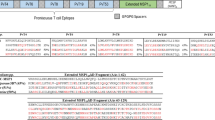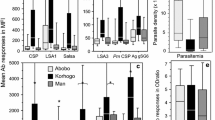Abstract
Although diagnosis of Plasmodium vivax malaria has been difficult when it is present at a low parasite density, it was recently revealed that an antibody assay was a good method of screening for malaria in blood banks. However, the use of this method for the diagnosis of malaria is limited due to the persistence of specific immunoglobulin (Ig) G. Therefore, we evaluated specific IgM antibody responses against the C-terminal region of the merozoite surface protein 1 of P. vivax (PvMSP1c) in sera obtained from patients with vivax malaria using various assays. The IgM capture enzyme-linked immunosorbent assay showed good sensitivity (97.7%; 308/315) and specificity (99.1%, 446/450). In addition, the results of this assay were not related to parasite density, and a high reactivity was observed when there was a low level of parasitemia. Furthermore, we found that patients with cases of malaria that had relapsed still had the IgM titers against PvMSP1c. Therefore, the use of IgM ELISA for the detection of specific IgM that was not involved in memorial immune activity could be an alternative tool for the diagnosis of malaria and blood screening, even in areas in which malaria is endemic.



Similar content being viewed by others
References
Alves FP, Durlacher RR, Menezes MJ, Krieger H, Silva LH, Camargo EP (2002) High prevalence of asymptomatic Plasmodium vivax and Plasmodium falciparum infection in native Amazon populations. Am J Trop Med Hyg 66:641–648
Balmaseda A, Guzman MG, Hammond S, Robleto G, Flores C, Tellez Y, Videa E, Saborio S, Perez L, Sandoval E, Rodriguez Y, Harris E (2003) Diagnosis of dengue virus infection by detection of specific immunoglobulin M (IgM) and IgA antibodies in serum and saliva. Clin Diagn Lab Immunol 10:317–322
Branch OH, Udhayakumar V, Hightower AW, Oloo AJ, Hawley WA, Nahlen BL, Bloland PB, Kaslow DC, Lal AA (1998) A longitudinal investigation of IgG and IgM antibody responses to the merozoite surface protein-1 19-kiloDalton domain of Plasmodium falciparum in pregnant women and infants: associations with febrile illness, parasitemia, and anemia. Am J Trop Med Hyg 58:211–219
Cho D, Kim KH, Park SC, Kim YK, Lee KN, Lim CS (2001) Evaluation of rapid immunocapture assays for diagnosis of Plasmodium vivax in Korea. Parasitol Res 87:445–448
Chung JY, Kim MY, Lim KJ, Sohn MJ, Kho WG (2001) Evaluation of LG Malaria Anti-Pvä for diagnosis of Plasmodium vivax malaria in the Republic of Korea. Korean J Clin Pathol 21:67–71
Coleman RE, Maneechai N, Rachapaew N, Kumpitak C, Soyseng V, Miller RS, Thimasarn K, Sattabongkot J (2002) Field evaluation of the ICT Malaria Pf/Pv immunochromatographic test for the detection of asymptomatic malaria in a Plasmodium falciparum/vivax endemic area in Thailand. Am J Trop Med Hyg 66:379–383
Doderer C, Heschung A, Guntz P, Cazenave JP, Hansmann Y, Senegas A, Pfaff AW, Abdelrahman T, Candolfi E (2007) A new ELISA kit which uses a combination Plasmodium falciparum extract and Plasmodium vivax antigens as an alternative to IFAT for detection of malaria antibodies. Malaria J 6:1–8
Drakeley CJ, Corran PH, Coleman PG, Tongren JE, McDonald SLR, Malima R, Lusingu J, Manjurano A, Nkya WMM, Lemnge MM, Reyburn H, Riley EM (2005) Estimating medium- and long-term trends in malaria transmission by using serological markers of malaria exposure. Proc Natl Acad Sci 102:5108–5113
Feighner BH, Pak SI, Novakoski WL, Kelsey LL, Strickman D (1998) Reemergence of Plasmodium vivax malaria in the Republic of Korea. Emerg Infect Dis 4:295–297
Gaye O, Diouf M, Dansokho EF, McLaughlin G, Diallo S (1998) Diagnosis of Plasmodium falciparum malaria using ParaSight F, ICT malaria PF and malaria IgG Celisa assays. Parasite 5:189–192
Gutierrez A, Vicini J, Patarroyo ME, Murillo LA, Patarroyo MA (2000) Plasmodium vivax: Polymorphism in the merozoite surface proteins gene from wild Colombian isolates. Exp Parasitol 95:215–219
Kaslow DC, Kumar S (1996) Expression and immunogenicity of C-terminus of major blood-stage surface protein of Plasmodium vivax, Pv20019, secreted from Saccharomyces cerevisiae. Immunol Letter 51:187–189
Korea National Red Cross (2001) Blood bank business annual report 2000. Korea National Red Cross, Seoul
Lim KJ, Park JW, Sohn MJ, Lee S, Oh JH, Kim HC, Bahk YY, Kim YS (2002) A direct sandwich ELISA to detect antibodies against the C-terminal region of merozoite surface protein 1 could be a useful diagnostic method to identify Plasmodium vivax exposed persons. Parasitol Res 88:855–860
Lim KJ, Park JW, Yeom JS, Lee YH, Yoo SB, Oh JH, Sohn MJ, Bahk YY, Kim YS (2004) Humoral responses against the C-terminal rejoin of merozoite surface protein 1 can be remembered for more than 30 years in persons exposed to Plasmodium vivax. Parasitol Res 92:384–389
Mungai M, Tegtmeier G, Charmberland M, Parise M (2001) Transfusion-transmitted malaria in the United States from 1963 through 1999. N Eng J Med 344:1973–1978
Park JW, Moon SH, Yeom JS, Lim KJ, Sohn MJ, Jung WC, Cho YJ, Jeon KW, Ju W, Ki CS, Oh MD, Choe KW (2001) Naturally acquired antibody response to the C-terminal region of merozoite surface protein 1 of Plasmodium vivax in Korea. Clin Diagn Lab Immunol 8:14–20
Ratnam S, Tipples G, Head C, Fauvel M, Fearon M, Ward BJ (2000) Performance of indirect immunoglobulin M (IgM) serology tests and IgM capture assay for laboratory diagnosis of measles. J Clin Microbiol 38:99–104
Snounou G, Viriyakosol S, Zhu XP, Jarra W, Pinheiro L, Rosario VE, Thaithong V, Brown KN (1993) High sensitivity of detection of human malaria parasites by the use of nest polymerase chain reaction. Mol Biochem Parasitol 61:315–320
Soares IS, Levitus G, Souza JM, Portillo HAD, Rodrigus MM (1997) Acquired immune response to N- and C-terminal region of Plasmodium vivax merozoite surface protein 1 in individuals exposed to malaria. Infect Immun 65:1606–1614
Soares IS, da Cunha MG, Silva MN, Souza JM, Potillo HAD, Rodrigues MM (1999) Longevity of naturally acquired antibody response to the N- and C-terminal regions of Plasmodium vivax merozoite surface protein 1. Am J Trop Med Hyg 60:357–363
Udhayakumar V, Anyona D, Kariuki S, Shi YP, Bloland PB, Branch OH, Weiss W, Nahlen BL, Kaslow DC, Lal AA (1995) Identification of T and B cell epitopes recognized by humans in the C-terminal 42-kDa domain of the Plasmodium falciparum merozoite surface protein (MSP)-1. J Immunol 154:6022–6030
Wongsrichanalai C (2001) Rapid diagnostic techniques for malaria control. Trends in Parasitol 17:307–309
World Health Organization (2000) New perspectives malaria diagnosis. Report of a joint WHO/USAID informal consultation. WHO, Geneva
Yeom JS, Kim TS, Oh S, Sim JB, Barn JS, Kim HJ, Kim YA, Ahn SY, Shin MY, Yoo JA, Park JW (2007) Plasmodium vivax malaria in the Republic of Korea during 2004–2005: changing patterns of infection. Am J Trop Med Hyg 76:865–868
Acknowledgements
This work was supported by a grant from the Korea Science and Engineering Foundation through the Protein Network Research Center at Yonsei University and through the National Core Research Center for Nanomedical Technology (R15-2004-024-00000-0).
Author information
Authors and Affiliations
Corresponding author
Rights and permissions
About this article
Cite this article
Park, JW., Yoo, S.B., Oh, J.H. et al. Diagnosis of vivax malaria using an IgM capture ELISA is a sensitive method, even for low levels of parasitemia. Parasitol Res 103, 625–631 (2008). https://doi.org/10.1007/s00436-008-1023-3
Received:
Accepted:
Published:
Issue Date:
DOI: https://doi.org/10.1007/s00436-008-1023-3




